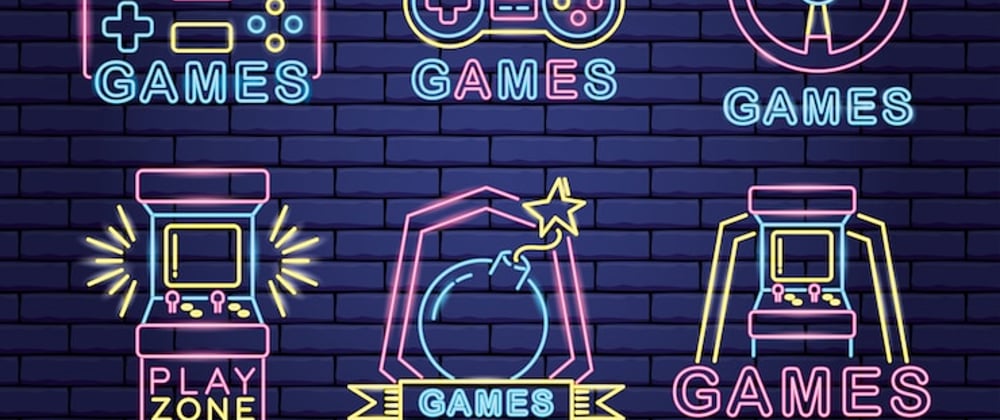Numerous surveys prove that more and more people choose gaming as their favorite pastime entertainment. Just imagine: there were 2.69 billion players in 2020. By the end of 2023, it’ll crush its new worldwide record of 3.07 billion. And this business is more than profitable. In 2022, global market revenue will achieve 188.13 billion, with smartphone-driven adventures dominating other platforms. The industry doesn’t seem to slow down: we’ll witness its further growth.
When did video games start? How did they originate? They have not always been as we know them. Bleeding edge realistic graphics, hooking stories, availability in a couple of clicks… Gaming evolved very fast, and its significant progress can hardly be compared to anything else. This entertainment form didn’t even exist until the latter half of the 20th century. But when the technology did appear, its further development happened by lips and bounds.
Let’s draw this evolution road, marking the key events for the sphere. We’ll cover how everything started and how it looked then and now.
Birth of the Gaming Concept
How long have video games been around? The history of this massive entertainment business started in the 1940th. Edward U. Condon made a program that can play Nim against a person. It would beat humans 90% of the time. This simple combinatorial challenge can be called the oldest game. Some began to understand that programs could be used for entertainment.
In the timeline of the 1950th, programmers developed simple electronic toys. Such as chess, tic-tac-toe, and tennis. A modern audience won’t find them interesting. But they served their purpose back then: they paved the way for becoming a cultural phenomenon.
1960s: First Steps in the Evolution of Video Games
In the 60th, the key events included 2 milestones:
In 1962, a student Steve Russell developed Spacewar!, a legendary shooter. It was multiplayer and quickly gained popularity.
In 1966, Ralph Baer suggested using TV screens for gaming. A year later, the inventor develops a prototype of a game console called Brown Box. The working principles inspired the American electronic company Magnavox to manufacture a similar device. Just 4 years later, Odyssey was the first console it produced: multi-player and multi-program.
1970s, Ten Years Later: Advancement of Arcade Machines and Consoles
Once bulky computers became smaller, they were put in 6-foot cabinets. They landed mostly in bars, shopping malls, and other public areas, attracting and entertaining crowds. It was the golden age of arcade machines. Manufacturers like Atari (the first company), Namco, Midway, and Taito made it to the market leaders.
Among the first commercially successful coin-operated machines was Pong. Created in 1972, it quickly found its way to many US cities. The toy was all over the news. 3 years later, Atari developed a home variant of this tennis arcade. Which made it one of the most played titles.
In 1974, the first networked FPS adventure was created – Maze Wars. It used tile-based wire-frame graphics and featured mechanics that would be adopted by other shooters. Doom including.
The market leaders kept designing the newest, most appealing, and engaging machines:
- 1. In 1978, Taito presented Space Invaders with endless levels of alien shooting
- 2. In 1979, Atari answered with Asteroids with multidirectional visuals
- 3. In 1980, Namco released Pac-Man, an action maze chase challenge
During this period, the US was flooded with video arcades. People went crazy playing them and always came for more. Some cities even passed laws that set limitations on where to place the entertainment gear.
But the console revolution started to quietly gain its power. In 1977, Atari produced the Video Computer System – the legendary Atari 2600. It had a joystick, cartridges, and switches for choosing games/complexity levels. But most importantly, it supported titles with colored images. The system found its way to the home of almost every American.
Consoles Take Over
Arcade machines were still popular at the beginning of the 80th. In 1981, Nintendo created Donkey Kong, better known to us as Mario. The game was ported to almost every known system. It laid a foundation for a huge franchise.
In 1983, the market became oversaturated with low-quality console adventures. Even Atari 2600 released titles that no one wanted to buy. Cartridges were just thrown away like garbage. This is when Japanese companies (e.g. Nintendo, Sega, etc.) successfully entered the market.
Nintendo created NES, 8-bit home gear in 1985, and then Game Boy in 1989. The latter was a handheld device with a convenient design, smooth gameplay, and long battery life.
As for the milestone toys, it’s worth marking 2 of them:
In 1984, a Russian mathematician invented Tetris, a hooking puzzle challenge. Nintendo and other manufacturers added it to every console.
The Legend of Zelda became popular when it was released in 1987 by Nintendo. Other iconic role-playing fantasies are Dungeons&Dragons and Leisure Suit Larry, a hot RPG for adults.
Heated Console Wars and the Advancement of PC Gaming
A leader in console systems Sega created an iconic hero in 1991. Sonic the Hedgehog was a favorite character that boosted the company’s sales. However, its end was inevitably coming closer.
In 1995, Sony produced a cheaper device, PlayStation. Although it didn’t beat Sega in sales, it was very close to it. A year later, Nintendo 64 weakens the leader even more. When PlayStation 2 hit the market in 2000, Sega died.
Meanwhile, PCs started entering the gaming market, with Microsoft adding Solitaire to the system (1990). In 1994, Doom was designed for MS-DOS. A year later, Warcraft: Orcs and Humans was released for the same OS. During this period, a rating system was established due to increased violence in digital toys. People wanted to limit access to too aggressive content for kids.
Machines became cleverer than humans. In 1997, the supercomputer Deep Blue beat the brightest chess mind of that time – Gary Kasparov.
Now let’s jump from 1990 to 2000 to witness the true progress of gear.
Tech Gets Better
The evolution of gaming was boosted by technological progress. Graphics cards, processors, and CPUs got more advanced. Performance hit made digital worlds closer to modern standards of realistic visuals. Check out this article to see how technology influences the industry nowadays.
In 2001, Microsoft jumped into the competition by introducing Xbox. Its further modifications were equipped with gear for better graphics delivery. Xbox 360 opened new opportunities for online play. Xbox Live was meant for a multiplayer experience.
During this time, the way we bought adventures also changed. Valve launched its Steam for digital distribution: it strengthened the PC positions. Players also witnessed the advancement of MMORPG. World of Warcraft became a hit among online entertainment options, with 10+ million followers in 2008.
As for Nintendo, it continued to dominate the industry of handheld devices. Its 2004 DS controller was the most often bought gaming gear. Sony also went this way, manufacturing the PSP (2004) and PlayStation Vita (2011). But Nintendo added revolutionary elements to its 2006 Wii. It introduced movements and encouraged players off their coaches. For example, with Wii Sports, the controller turned into a racket, bat, and other things. The company reached out to people who would never call themselves gamers.
When video titles became available on phones, the mobile market started to gain power. Angry Birds and Farmville received massive revenues in 2009. It was clear back then: mobile devices were a promising sphere. Later, developers would create lots of addictive crowd-gatherers like Clash of Clans or Candy Crush.
Rapid Changes Go On
Indie, Online, and IO
The market exploded when an indie creation Minecraft became a popular phenomenon in 2010. Sandbox multiplayer title had simple block-based visuals and no limitations for creativity. A few years later, browser-driven adventures like Agar.io and Slither.io reshaped the meaning of multiplayer matches. They made rounds short, allowed players to move online, and introduced simple gameplay. It totally blew the Internet. Nowadays, one can find lots of IO games and access them from any device.
AR/VR
Augmented reality first showed its potential in 2011 with the release of Skylanders: Spyro’s Adventures. 5 years later, Pokemon Go united our and digital worlds. The hit allowed players to use streets as a playing environment, which was a sensation. As well as a new trend to develop.
Mature Stories
At the same time, video games changed society and its values. The audience started to crave mature and emotional stories. Titles didn’t only offer to do something you can’t do in real life. They also tied you to characters with hard and moral-driven choices. The Last of Us (2013) is a bright example and among the best action adventures.
Esports
Esports was born in the 1990s, but it turned into a serious business in 2015. It was the time when Twitch started to bloom. It attracted millions of viewers to watch e-championships. Professional esportsmen competed with each other in Fortnite (DOTA 2, Call of Duty, etc.). According to Newzoo, global esports revenue will be over $1.38 billion in 2022.
Wrapping Up
How has gaming changed over time? Now you can track the development and make comparisons. Then and now are very different. Altered old and new genres, more convenient purchasing methods, and even much-evolved gameplay. Computer toys are mainstream today, with a variety of options for any player. As technology gets better in every way, it’ll make them even more realistic and addictive. More cool video games will come out. They’ll further boost the vibe of the industry. Trust us: you won’t recognize it in the next ten years!







Oldest comments (3)
Thank you for this article. Jackpot City casino does not yet offer such a rich selection of slots as competitors, but there are plenty to choose from - licensed software from world-famous brands, bright design of slots, numerous bonuses that make the game even more interesting - just an incomplete list of advantages, on which you can expect when choosing games of chance from Jackpot City casino mycasinosguide.com/casino/jackpot-....
It's pretty wild to realize that the games our grandparents played, like "Pong" or "Pac-Man," have transformed into the immersive worlds of "The Witcher" or "Cyberpunk 2077." The blend of storylines, graphics, and tech has really pushed the experience to new heights! Another fascinating angle to consider is how gaming impacts us. For one, studies indicate that gaming can help boost concentration. Yep, you heard it right! Check this link out if you're curious js13kgames.com/p/boost-concentrati.... Just curious what you think about it.
Video games continue to evolve, starting with simple arcade games and moving to complex three-dimensional world-building projects with unique stories and gameplay. Advances in technology, including graphics, sound and artificial intelligence, allow games to become increasingly immersive and realistic servreality.com